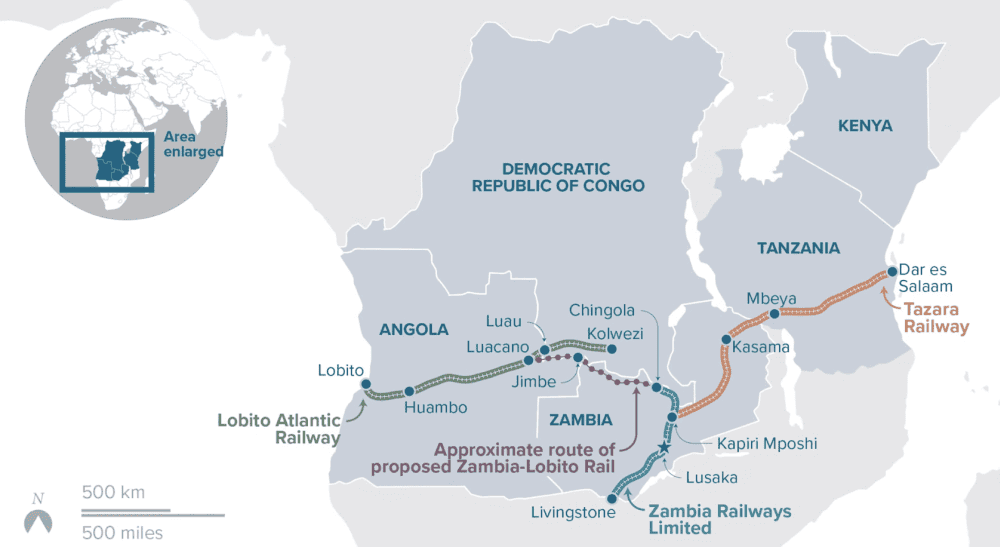
[Image above] A map showing the main railway routes in sub-Saharan Africa. The U.S. and European Union are supporting the modification and expansion of the west section run by the Lobito Atlantic Railway company. Credit: United States Institute of Peace, YouTube
The U.S. government has been hard at work this past year supporting the launch of numerous mineral exploration and feasibility surveys as well as nascent mining projects in various states. These projects are funded with the goal of strengthening domestic supply chains for critical minerals.
But even if these projects are successful, the U.S. will still need to source some minerals from afar because of overwhelming demand for certain minerals and lack of local sources for others. In this regard, the U.S. government has involved itself with the Lobito Corridor initiative in sub-Saharan Africa.
Lobito Corridor: History and current status
The Lobito Corridor refers to a stretch of railway infrastructure that winds through mineral- and oil-rich parts of sub-Saharan Africa. It is viewed as a way to transport raw material quickly and efficiently from landlocked African mines to shipping ports, where it can be exported to refining hubs in other countries.
The Lobito Corridor starts at the port of Lobito, on the Angolan Atlantic Ocean coast, and runs approximately 1,300 km (800+ miles) to the town of Luau on the northeastern border of Angola with the Democratic Republic of the Congo (DRC) and within easy reach of northwestern Zambia. It extends an additional 400 km (~250 miles) into the DRC to the mining town of Kolwezi.
The rail route was established in the early 1900s and thrived until the mid-1970s, when damage sustained during the Angola civil war curtailed its use. It remained underutilized until the 2010s, when the Chinese government funded and conducted a nearly $2-billion rehabilitation effort to modernize the railway between 2006–2014.
Today, the railway is controlled by the Lobito Atlantic Railway company, a joint venture between Swiss commodities trader Trafigura, Portuguese construction company Mota-Engil, and Belgian private railway operator Vecturis. The company secured a 30-year concession in July 2023 to provide railway services on the condition that it would invest $455 million in Angola and $100 million in the DRC.
Development of the Lobito Corridor
In May 2023, during the G7 Summit in Japan, U.S. President Joe Biden announced the U.S. would support development of the Lobito Corridor as part of the Partnership for Global Infrastructure and Investment (PGII).
PGII is a collaborative effort by the intergovernmental Group of Seven. It aims to fund infrastructure projects in developing nations, and the Lobito Corridor is the first strategic economic corridor launched under the partnership.
In September 2023, the U.S. and European Union announced they had teamed up to support Lobito Corridor development, including by launching feasibility studies for a new rail line from Angola through Zambia’s Copperbelt region.
In October 2023, during the two-day Global Gateway Forum in Brussels, Belgium, delegates from the U.S., the European Union, the DRC, Zambia, Angola, African Development Bank, and Africa Finance Corporation signed a memorandum of understanding to cooperate on the Lobito Corridor development. This memorandum is on the back of a January 2023 agreement between the governments of Angola, the DRC, and Zambia to cooperate and harmonize relevant regulations.
Limitations of the Lobito Corridor
Though development of the Lobito Corridor will make transport of minerals within Africa easier, it may not secure critical mineral supply chains like the U.S. hopes, as explained in a Harvard International Review article by deputy managing editor Isabelle King.
The first limitation is that Chinese firms own 15 out of the 19 major mines in the DRC, and the remaining four often sell their raw material to China. So, “The mere existence of a Western-friendly railway with an Atlantic orientation does not directly lead to Western acquisition of the metal,” King explains.
On top of that, even though the Lobito Atlantic Railway operates the rail lines, two Chinese firms won the public tender for the port of Lobito in 2022. These firms now hold the rights to operate the port for 20 years.
Finally, the Lobito Corridor is not the only mine-to-port railway in southern Africa. In February 2024, China announced plans to invest more than $1 billion in upgrading a rival set of tracks, the Tazara Railway, which runs eastward from the Zambian copper mines to the Indian Ocean port of Dar es Salaam.
King also points out that because the Lobito Corridor initiative revolves around exporting the minerals for refining, it excludes the mineral-rich African countries from reaping the monetary benefit of the industry, which “does not correspond with the intentions of the Congolese and Zambian governments.”
She argues that if the U.S. and European Union help these countries establish local refining capabilities as described in the September 2023 memorandum, “This kind of value-adding investment, rather than infrastructure aimed at exporting the continent’s natural resources, could lay the foundation for a more holistic relationship between the West and sub-Saharan Africa.”
